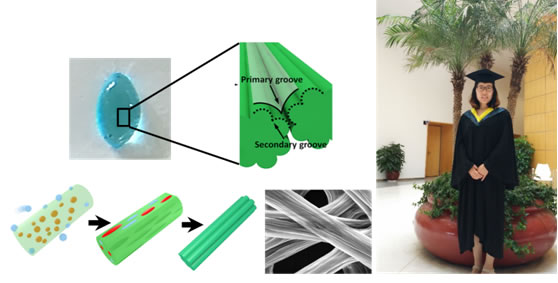Researchers from Department of Nonwoven Material & Engineering have reported an important progress in the development of ultrafine grooved fibers and the wettability features. The related results have been published in NANOSCALE (Nanoscale, 2017, 9, 16214-16222), a well-known academic journal from the Royal Society of Chemistry.
Through millions of years of natural selection and species competition, many creatures have evolved to possess exquisite structural features that are critical to their survival. One of the most intriguing structures is the hierarchical surface formed by grooved units at nanometer scale. For instance, large numbers of oriented nanogrooves from the setae of water striders enable the insects to stand effortlessly and move quickly on water. Also, the grooves on the surface of cactus spine endow the drought-resistant plant with excellent capacity of fog collection and water transportation.
In spired by these delicate architectures, the paper reports the development of similar grooved structures on polylactic acid (PLA) and other polymeric fibers through adjusting of the solvent ratio and RH during electrospinning. A double-grooved nonwoven surface formed by aligned fibers having longitudinally oriented nanogrooves is further constructed, which shows an enhanced anisotropic hydrophobicity. Such surfaces are found to have practical significance in fog collection. The double-grooved nonwoven surfaces developed in this paper, with the simple but versatile fabrication strategy, may offer technological promise in areas such as water collection, smart textiles, microfluidic control and tissue engineering.

Anisotropic hydrophobicity on a nonwoven surface formed by nanogrooved PLA fibers (left), and the photograph of the first author, Miss Meimei Liang (right).
The research was supported by the National Natural Science Foundation of China and the Key Laboratory of Textile Science & Technology. The article was published with Miss Meimei Liang as the first author, who will obtain her master degree this March.

